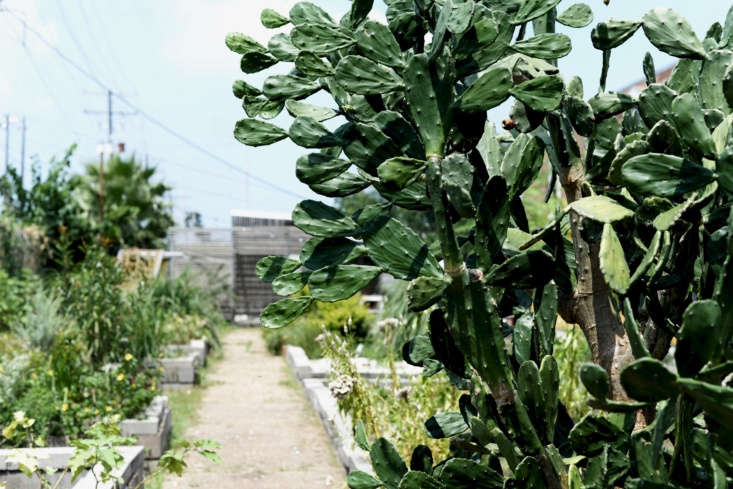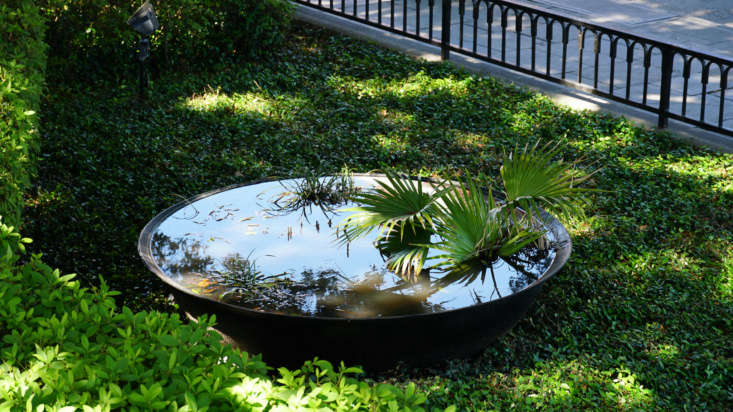One morning in 1854, after “thundering into New Orleans” on a riverboat, Frederick Law Olmsted had a bath and some breakfast at his hotel and then wandered onto an intoxicating scene: “I was delighted when I reached the old Place d’Armes, now a public garden, bright with orange and lemon trees, and roses, and myrtles, and laurels, and jessamines of the south of France,” he wrote in one of many newspaper dispatches later collected into the book A Journey in the Seaboard Slave States.
What a seduction the landscape must have performed on a young man who had not yet designed New York’s Central Park or become known as America’s most famous garden designer. Olmsted had come to town to chronicle daily life in a part of America where it was legal for some humans to own others as slaves. But in New Orleans the future landscape architect also fell under the spell of perfumed flowers, untamed vines, and the spell of lethargic, heavy humidity that encouraged the resident tropical plants.
More than a century and a half later, I visited New Orleans and can report that its gardens still look like no others in the world. After thundering into the city by air, I went on a walking tour of the Garden District—with an amazing guide: Katrina Horning of New Orleans Architectural Tours, a historic preservationist with a special interest in Louisiana studies. For two hours, she led our group of a dozen tourists past the neighborhood’s grand mansions, blooming magnolias, and mossiest cemetery (where volunteer ferns sprouted in crypts’ cracks).
“We allow our gardens to do their own thing—to overgrow a bit rather than to manicure them,” Horning says.
Thanks to the city’s particular climate and geography and architectural style—not to mention its swamplands, floods, hurricanes, deposits of rich alluvial soil, and pestilential insects—you can look at a photo and know immediately: This is New Orleans.
Here are 10 garden ideas to steal from New Orleans.
Jessamine

You say jasmine, I say jessamine. By any name, the fragrant flowering vines can instantly dress up a wall, fence, or arbor. In New Orleans, star jasmine (Trachelospermum jasminoides) twines around fences and Asiatic jasmine (T. asiaticum) is a fast-growing ground cover.
Draping Greenery

“Because of the very warm and rainy climate, it’s better to let vines do their own thing rather than to try to make them look held back,” says Horning.
Ferns in Cracks

Ferns flourish in cool, damp cracks. In a shady spot, you can encourage them to grow in a wall or the crook of a stair step. See more examples in 10 Garden Ideas to Steal from Ireland.
Courtyard Gardens

The famous courtyard gardens of the French Quarter date to the mid-20th century (and stricter building codes enacted after catastrophic 19th-century fires were fueled by open spaces between buildings). Emulate the look in a small courtyard garden: Build raised beds to visually expand the plantings and add a fountain as a focal point.
Filigree Fences

From wrought iron fences to the fancifully ornamental cast iron designs that characterized Italianate architecture in the mid to late 1800s, the gardens of New Orleans are guarded by privacy barriers that are stylish without sacrificing security.
When cast iron was developed in the 1840s, it opened up a whole new world of fanciful possibilities. “It led to the ability to have all kinds of delicate and light shapes, from fences covered with beautiful flowers to fences that looked like corn stalks,” says Horning. Today custom cast iron fences, railings, and gates are still available from sources such as Heritage Cast Iron USA.
Double Harvest

Growers of edible gardens in New Orleans plant two seasons of crops: the first in early spring and the second in late summer (the excessive heat of the hottest months is not conducive to growing edibles).
To follow suit, try growing citrus trees in portable pots (which makes it easier to regulate irrigation and exposure to the elements).
Italianate Flourishes

In the 1800s, “Italianate architecture was a reaction to the plain and boxy shapes of Greek Revival,” says Horning. “A lot of cast iron fences from that period were poured into patterns of plants, and a lot of them are painted green—maybe we’re trying to emulate plants with our cast iron.”
Southern Live Oaks

The southern live oak trees of New Orleans are Quercus virginiana, with generous canopies that grow horizontally to shade streets, gardens, and walkways. “In our climate, you want shade. It’s very hot,” says Horning.
Native to North America, southern live oaks thrive in USDA growing zones 7b to 10b and at maturity will have canopies that spread as wide as 120 feet. Plant accordingly.
Tropical Plants

A port city, New Orleans has become home to plants from Central and South America, the Caribbean, and Asia.
“By the 1920s, local nurseries and seed houses were supplying vegetable seeds and ornamental plants to customers throughout the Gulf South region,” writes Lake Douglas in his book Public Spaces, Private Gardens: A History of Designed Landscapes in New Orleans ($29.95 on Amazon).
Water Features

In a hot, humid climate, nothing is more refreshing than the cooling sight and sound of running water. If you’re considering a garden fountain, see Everything You Need to Know About Fountains.
N.B.: This post is an update; it was first published May 2018.
If you’re designing a garden from scratch (or just rehabbing a hardscape feature or two), start with our Garden Design 101 guides to Perennials 101, Vines & Climbers, and Fences & Gates. Read more:
- Magnolia Trees: A Field Guide to Planting, Care & Design
- The Vampire Diaries: A Plantation Haunted by History
- 9 Ways to Create Curb Appeal with Flowering Vines and Climbers









Have a Question or Comment About This Post?
Join the conversation